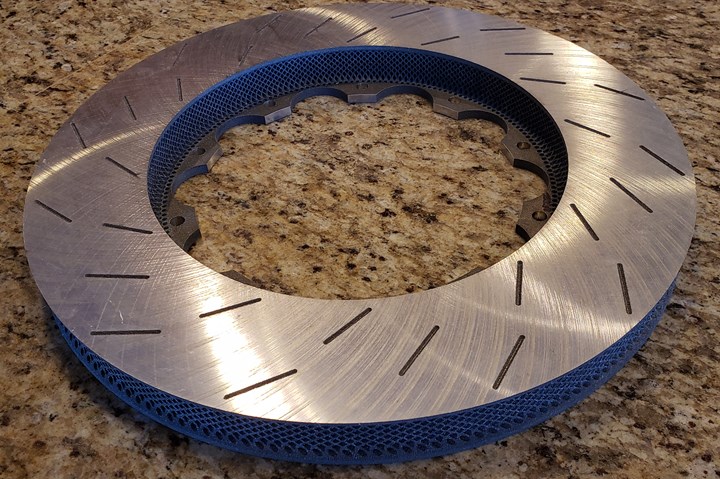The ability to 3D print in metal has brought new geometric possibilities to manufacturing for production — but what if metal alone doesn’t quite cut it for your application?
Metal matrix composites (MMCs) are a potential solution for cases where a straight metal alloy might be too heavy, too susceptible to temperature changes, or wear too quickly. The use of fillers in these materials can help reduce the weight of a metal part while also increasing its temperature and wear resistance. Combined with additive manufacturing (AM), users get these material benefits plus geometric freedom.
In the second episode of The Cool Parts Show Live, we’ll be looking at a case where an MMC applied additively offers a dramatic improvement over conventional technologies and materials: a high-performance brake rotor 3D printed from an aluminum alloy with ceramic fill.

This brake rotor is 3D printed from A100-RAM10, an aluminum alloy with ceramic fill from Elementum3D. Photo Credits: Elementum3D
Michael J. Kawecki, founder of Ceramic Disc Technologies (CDT, the creator of this rotor), and Adam Polizzi, materials and metallurgical engineer at Elementum3D (which developed the MMC used in this rotor), will join Peter Zelinski and me for the live session next Tuesday, January 12 at 3:30 p.m. Eastern. Learn how this cool part came to be and bring your questions!
The live session will be accessible for free through IMTS spark. Register for the platform here, and then be sure to add the session to your MySpark planner to gain access to the livestream.
(You can also view an archived version of the first installment of The Cool Parts Show Live, in which Pete and I learned about the Mighty Duct, a polymer part made for the HP Multi Jet Fusion 3D printer on a Multi Jet Fusion 3D printer. See our conversation with Luis Baldez of HP and Ashley Eckhoff of Siemens about this part.)
Related Content
-
Aircraft Ducts 3D Printed in Composite Instead of Metal: The Cool Parts Show #68
Eaton’s new reinforced PEKK, tailored to aircraft applications, provides a cheaper and faster way to make ducts compared to formed aluminum.
-
3 Unique Elements of LFAM to Consider in Design
While similar to desktop fused filament fabrication (FFF), large format additive manufacturing (LFAM) in polymer composite poses several unique challenges as a result of its scale.
-
Video: Reinforcing (and Joining) Parts After 3D Printing
Reinforce 3D has developed a method that can be applied to strengthen 3D printed parts by feeding continuous fiber and resin through them. The technique also enables joining parts of various materials and manufacturing methods.


.jpg;width=70;height=70;mode=crop)









